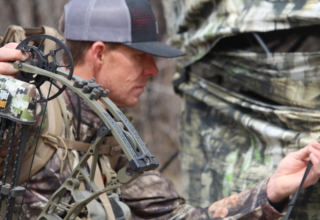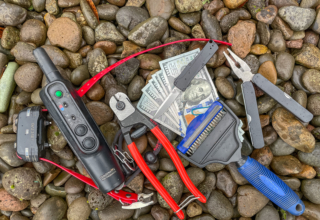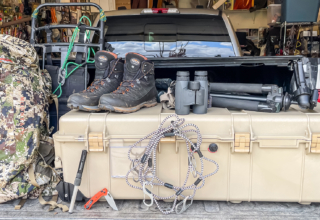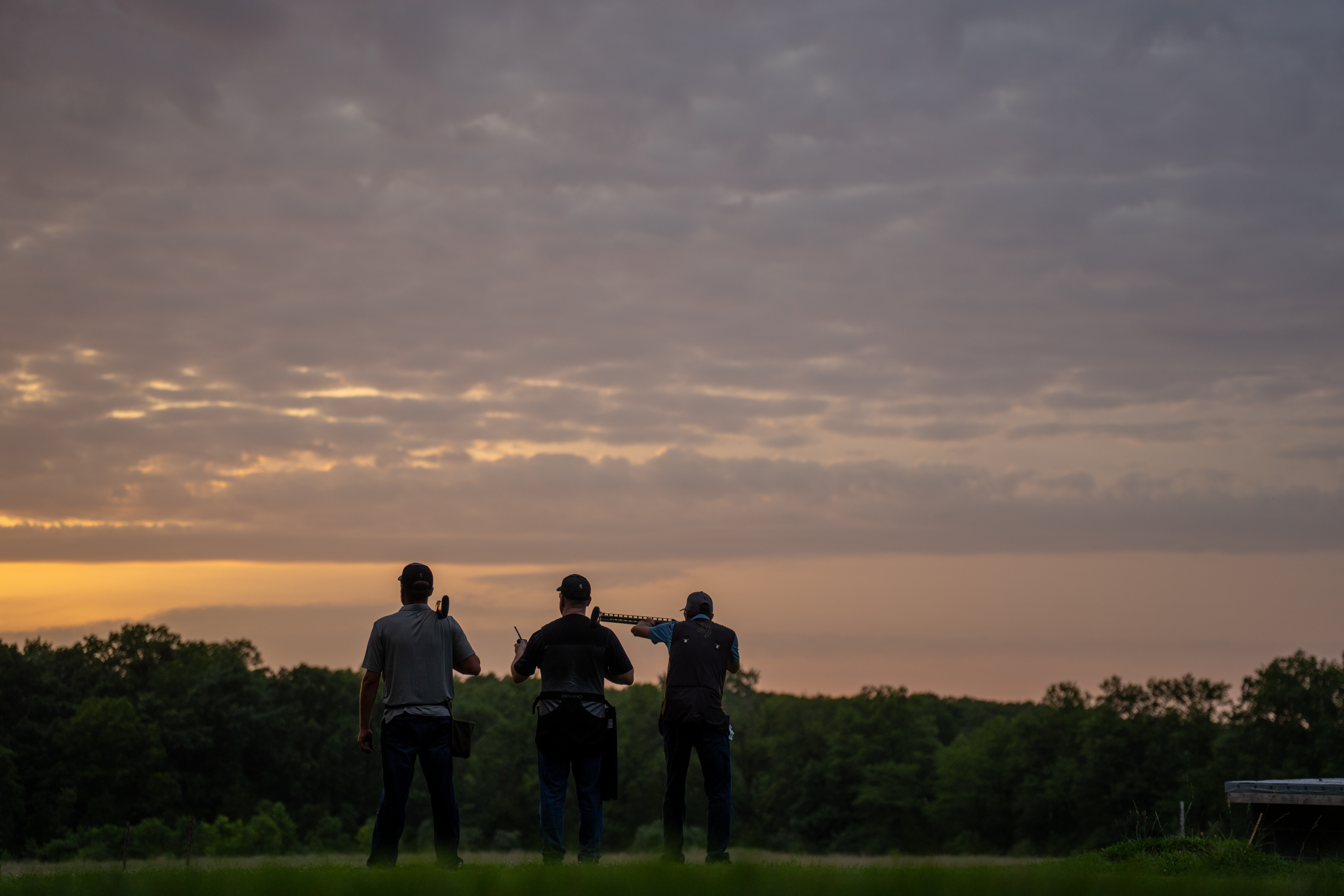Time is running out, but if you still have a turkey tag in your pocket and the season is still rolling, don’t wave the white towel. Instead, heed Haugen’s late-season turkey tactics and fill that tag.
by Scott Haugen
It was the final week of the spring turkey season. Gobblers were fired up but leery. They stuck to the woods, reluctant to enter open meadows in the hills I hunted. I had time, so rather than continue hammering them with calls that weren’t fooling them, I backed out and returned two days later.
This time, I toted a breeding hen decoy. I set it on a deer and elk trail, which the turkeys routinely used. At first light, I let out a yelp and got a distant gobble. Fifteen minutes later, a lone tom appeared, strutting but silent. It waltzed into the decoy, and I hit it with a payload of HEVI-18 TSS fired from the trusty 20 gauge. And just like that, my last tag of the season was notched.
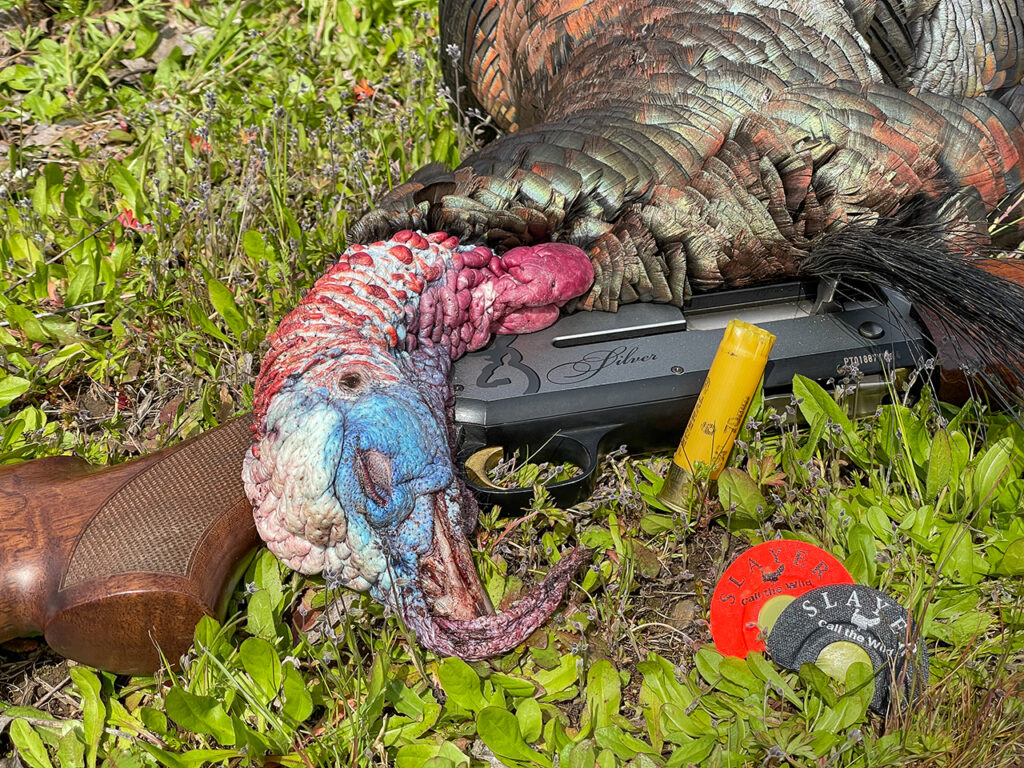
Why did I go with a breeding hen decoy this late in the season? Predators had wiped out nearly every poult in the area over the previous five weeks. This left many hens looking to breed. Throughout the West, the peak of the breeding season runs from late February to mid-April. In higher elevations, the breeding season can be delayed a week or two, even more, depending on the amount of snow, cold temperatures, and availability of food.
Up to 50 eggs can develop inside a hen during a single mating session with one tom. When it’s time to start laying, the hen will build a nest and lay one egg every 24 to 32 hours. The average size clutch is 11 to 12 eggs. The hen waits until the final eggs are laid before incubating the clutch, which hatches 28 days later.
If a brood dies early in the spring, the hen can re-nest without breeding. If the hen loses two clutches or one perishes later in the spring, she will have to breed again to lay more eggs. That’s precisely what happened on this final hunt of the season. This is something I’ve seen many times over the years. Breeding can take place into August if a hen continues losing broods. This is just one late-season trick I’ve learned over the years.
Multiple Calls
In the late season, I firmly believe that the greater the variety of turkey calls in the vest, the better the chance of them calling in a tom. To maximize the sounds a turkey hunter can deliver, utilize multiple calls. This is different than my typical early-season approach, where I’ll often use only one or two calls and move on if a tom doesn’t come in.
Late in the season, you may see fewer toms because most of the breeding is done. The toms are back to feeding and even forming bachelor flocks. Once I find a tom late in the season willing to talk, I’ll stick with it as long as I can, persistently calling to entice it.

I commonly sit in one spot and use two box calls, an array of diaphragm calls, and three slates with 15 strikers, which is like having 45 different sounds. Sometimes, I even use a gobbler call. If I know a tom is within earshot during the late season and my time is running out, I might stay put for a few hours and work the bird. The objective is to find what sound the hung-up tom likes. I don’t know how often I’ve called for two or three hours in this situation from one spot and finally got a finicky tom to commit.
For the last three seasons, my go-to diaphragm calls have been the complete line of Slayer Calls turkey calls. I’ve called in hundreds of birds with these reeds for both hunting and photography. They hold up and sound incredibly good. My box calls are all-weather for the damp conditions I often hunt in, and I use glass, aluminum, and slate surface pot calls.
Don’t be in a rush, as aggressive, loud calling isn’t the goal.
“I’m more patient late in the season,” shares noted guide Jody Smith of Jody Smith’s Guide Service, who has had nearly 100 percent success taking upwards of 60 hunters a year for the past couple of decades in western Oregon.
“I do more patterning of birds late in the season. Then, I set up and call based on their movements. I call in more toms this time of year using a variety of sounds, but I don’t call as aggressively as I did early in the season. Most of the birds we get this time of season are taken in the afternoon, not in the morning. You have to be patient and work them.”
Big Country Calling
Calling in the vast, rugged land of the Rockies, Cascades, or brush-choked Coast Range is far different than working birds in lowland habitats. In big country, wind, weather, and topography can all impact how far sounds travel.
Personally, I like getting high and letting loose with some cuts and cackles to locate toms. These high-elevation birds are usually up early, and I want to go in with hopes of catching their attention right away.
“You can’t get too loud when it’s raining and windy, and your sounds have to penetrate thick forest and brushy draws,” notes Smith. “Sometimes, when toms answer back, it sounds like they’re a mile away when they’re barely 100 yards off.”
I’ve noticed many of these high country, often solo toms, to be quiet and elusive.
“The thicker the brush, the more silent these late-season birds seem to be. I think high predator numbers are a big reason for that,” continues Smith. “We have a lot of coyotes, bobcats, and cougars around, and the birds are wary. A lot of toms will gobble one time, a 1/2-mile or more away. Then they will shut up and not say a word. The next thing you know, they’re on top of you.”
That’s exactly what happened in the case of my late-season hunt described in the beginning.

Covering ground on foot, mountain bike, ATV, even horseback, are great ways to locate turkeys throughout the West. Don’t overlook quality binoculars and even a spotting scope which are often valued tools of the Western turkey hunter.
Fourth-Quarter Decoy Options
Late in the spring turkey season, I’ve successfully used full strut decoys alone and when paired with a hen decoy. Smith has had great success using a Dave Smith Decoy Strutter.
“We’ve been 100 percent on it the last three seasons, and it’s a great late-season decoy where tom densities are high,” said Smith.
I’ve had good luck with the Strutter set next to a DSD Preening Hen decoy inside the timber on late-season mornings when meadows and forest floors are wet from rain or damp with dew.
The new Final Approach Live Breeder Hen is a decoy I’ve used a lot this season. Earlier this month, I used it in a heavily hunted section of river bottom that public land hunters often hammer. I left the gun at home, grabbing the camera because I needed a few pictures of toms in this habitat. The first tom approached the Breeder Hen at 5:45 a.m. More toms trickled in, and for three solid hours, toms were harassing the Breeder Hen. I took over 2,700 photos that morning. I’ve also hit turkey pay dirt with the Final Approach Live Jake decoy I use this decoy alone and along side the Breeder Hen.

A trail camera is a final tool that’s helped me a lot in the late turkey season. Recently, I started running Moultrie Mobile Cellular Trail Cameras. I’ve used trail cameras for many years and love the knowledge they provide. I started with three of the Edge Pro trail cameras. Now, I have over 30 of them set out just for turkeys. The information these cellular trail cameras reveal about tom and hen numbers, when and where birds move, and even predator pressure and nesting success has had a direct and immediate impact on when, where, and even how I hunt.

With turkey season winding down, don’t wait. Study turkeys and let them dictate your next move. With ever-changing weather conditions, predators, and big country, covering ground and hunting smart is the key to filling that final tag.




